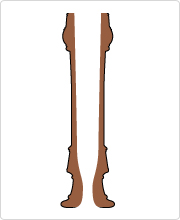The Structure of the Recorder
How is the sound of a recorder produced?
Recorder scale secrets
Among the features that contribute to producing the sound of the recorder, the size of the tone holes, their location, and the internal shape of the bore (the mensur) are the three most important factors. These three are closely related to producing the pitch of the sound made by the recorder.
Tone hole size
If you look closely at a recorder, you will see that the size of the holes varies. The locations of the holes and their alignment with the interior shape of the bore have been developed through over 500 years of trial and error, with the aim of producing tones at different pitch intervals.
To this end, a variety of approaches have been used. For example, for the double holes, where there are two open holes in one place, the combined surface area of both holes is the same as the surface area of a single hole for a single tone.
Also, when holding in the instrument, if only the hole on the right is covered a note at a semitone interval is produced, but if both of the holes were made to be exactly the same size, the interval produced would not be a semitone.
The lower two double holes, covered by the little finger and ring finger of the right hand, also may appear at first glance to be the same size, but if you look closely you will see that they are actually different sizes.
Tone hole position
The tone holes of a recorder tend to be thought of as being positioned at regular intervals, but that is not actually the case.
They are not at regular intervals, nor are they all positioned in a straight line. The holes are not in a straight line because they are positioned so as to be easier to cover with the fingers.
In fact, providing they are positioned at the same height in the bore, the same pitch of sound will be produced irrespective of where they are placed on a circumference of the bore at that height. If you try stretching your fingers, you will find that on the human hand, the middle finger and the ring finger are harder to stretch than other fingers. Therefore, for the position of the holes on a recorder, the space between holes covered by the middle finger and the ring finger is also minimized.
In accordance with the closely related pitch of the notes and size of the holes, the locations for all of the holes have been precisely adjusted so as to be easy to cover with the fingers.
To give an example of the relationship between the positions of the tone holes and their size, if the position of the hole is moved farther down the bore of the recorder, the pitch of the sound can only be preserved by making the hole bigger. Conversely, when the hole is repositioned higher up the bore, it will be designed to be smaller.
For a wooden recorder, if the pitch is found to be very slightly out during the final tuning, the size of the hole will be finely adjusted using a knife.

The photograph shows a wooden alto recorder. It has holes that vary in size, and form an arc that make them easy to cover with both right and left hands.
Internal shape of the bore
When seen horizontally, the interior of the bore of a recorder is not directly straight, but instead traces a free curve. This is to say that it is not a cone that connects two points in a straight line, but is instead a gradually changing curve. With the sound being squeezed out towards the bottom of the bore having traveled straight down from the top, the line of the flow is distinctive.
If this internal shape of the bore is changed, the pitch of the sound produced also changes even if the length of the bore, the holes, and the way those holes are covered remains unchanged. The current shape has been formed through various trial and error endeavors such as narrowing the inner diameter for certain sections.

Diagram of the internal bore of a recorder
